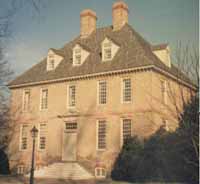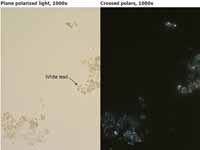Cross-section Microscopy Analysis of Exterior Paints: North Door Pediment at the President's House of the College of William and Mary (Block 16, Building 2), Williamsburg, Virginia
Colonial Williamsburg Foundation Library
Research Report Series - 1738
Colonial Williamsburg Foundation
Library
Williamsburg, Virginia
2012
Cross-Section Microscopy Analysis of Exterior Paints
North Door Pediment at the
President's House of the
College of William & Mary
(Block 16, Building 2)
Williamsburg, Virginia
Table of Contents
| Purpose | 1 | |
| Sampling Procedures | 2 | |
| Results of Cross-Section Analysis | 3 | |
| Results of Binding Media Analysis with Fluorochrome Stains | 7 | |
| Results of Pigment Identification | 8 | |
| Results of Color Measurement | 9 | |
| Conclusion | 10 | |
| Appendix | ||
| Sampling Memorandum | 11 | |
| Cross-Section Preparation Procedures | 12 | |
| Binding Media Analysis Procedures | 12 | |
| Pigment Identification Procedures | 12 | |
| Color Measurement Procedures | 13 | |
| Contact Sheets of Cross-Section Photomicrographs | 14 |
Cross-Section Microscopy Analysis of Exterior Paints
| Structure: | North door pediment, President's House, College of William & Mary |
|---|---|
| Requested by: | Edward A. Chappell, Director, Architectural Research Department, Colonial Williamsburg Foundation |
| Funded by: | A Fidelity Foundation Grant to Colonial Williamsburg Foundation |
| Conservator: | Natasha K. Loeblich, Architectural Paint Analyst, Architectural Research Department, Colonial Williamsburg Foundation |
| Consultant: | Susan L. Buck, Ph.D. Conservator and Paint Analyst |
| Date: | April 26, 2007 |
Purpose
The goal of this project is to use cross-section microscopy to identify the early finishes, if they are present, in samples from the pediment over the north door of the President's House at the College of William & Mary. On May 12, 2006 the repairs being made to the brickwork of the chimneys required extensive scaffolding on the north face. The scaffolding allowed access to protected areas not previously sampled on the eighteenth-century pediment over the north door. Edward Chappell used this opportunity to take ten samples from this element. This report follows an earlier examination of paint samples from interior and exterior of the house.1 Susan Buck also completed a study of selected interior and exterior finishes at the President's House.2
The President's House was built in 1732-33, but was damaged in a fire in 1781 while French troops were stationed there. It is not clear exactly how much damage the building suffered at that time. Archeological excavations by Colonial Williamsburg staff in 1972 indicated that the central east-west wall had been rebuilt from floor level.3 Based on this information they theorized that the house was gutted and few, if any, trim elements could have survived the fire.4 Dendrochronology has just confirmed that the roof was entirely rebuilt after the fire. The house was restored, along with other colonial buildings at the College, in 1931.
The pediment over the north door sampled for this report is suspected to have survived the 1781 fire. It may be one of the few exterior eighteenth-century elements that remain at the College of William & Mary. Hence, if the original exterior trim color can be determined it might be useful in the presentation of the college structures and other major civic buildings in Williamsburg where the finish history has been completely lost.
Sampling Procedures
Ten samples were taken from the pediment over the north door. The woodwork samples were lifted with an X-acto blade by Chappell. The samples were collected on site in labeled paper envelopes and each was given a unique number that corresponds to the recorded sample locations. Before analysis, the samples were renumbered in sequential order beginning with number twenty-five as twenty-four samples had been taken from the structure in February of 2006. The exact sample locations for the current set of samples are as follows:
| PH25 (1) | Westernmost (side) modillion, north face at upper east corner adjoining cymatium |
| PH26 (2) | Penultimate modillion from the east (westernmost front), east side at upper south corner adjoining cymatium |
| PH27 (3) | Second (first front) modillion, counting from east, north face 1" below cymatium |
| PH28 (4) | Second (first front) modillion, west side, ½" back from front, adjoining cymatium |
| PH29 (5) | Fascia between second and third modillions 1" east of third one, adjoining cymatium |
| PH30 (6) | Fascia between second and third modillions, at junction with bed molding fillet |
| PH31 (7) | Third (second front) modillion, middle of west cymatium |
| PH32 (8) | Upper (raking) fascia beside middle (top) modillion, adjoining cymatium |
| PH33 (9) | Westernmost upper (raking) modillion, west lower edge ¾" back from front |
| PH34 (10) | Upper (raking) soffit, 1" west of second modillion, 2" back from fascia |
Results of Cross-section Analysis
The cross-sections indicate that finish history on the pediment over the north door begins with six dark cream-colored paint layers before an unusual olive green layer is applied. All the samples containing wood substrate and early paint finishes have evidence of an orange fluorescent sealant in the wood when viewed under reflected ultraviolet light. The most complete cross-sections came from the two samples from the westernmost side modillion and the westernmost front modillion, samples PH25 and PH26 respectively.
The cross-section below from the westernmost front modillion has a disrupted fragment of the wood substrate with pockets of the natural resin sealant and tiny remnants of the first paint layer.
 Sample PH26 from the westernmost front modillion
Sample PH26 from the westernmost front modillion
The earliest generations of paint in both sample PH25 and sample PH26 are dark cream-colored. These early paints are weathered with thick grime layers and mold growth. The cross-sections from both samples appear to have six generations of early dark cream-colored paints. However, the early paints are cracked and dirty making it hard to be sure of the stratigraphy of the layers. The early paints have some autofluorescence in reflected ultraviolet light which may indicate the presence of lead white pigment which has a characteristic bright autofluorescence. These layers stained weakly for the presence of oils when the fluorochrome stain DCF was applied. It seems likely that these layers are common oil paints. The fluorochrome stain TSQ was also applied and stained the bottom white paint layer of the sample. This is a modern paint containing zinc white pigment that flowed through cracks to become trapped below the earlier layers. There is evidence of an orange fluorescent resinous varnish on the early layers. It is not clear which layer was covered with the varnish since many of the layers cracked and the varnish flowed around the flakes.
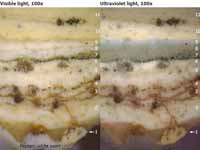 Sample PH25 from the westernmost side modillion
Sample PH25 from the westernmost side modillion
A cross-section from sample PH26 is shown below and also has evidence of the first generation of dark cream-colored paint. Generation seven in the samples is a unusual olive green paint with a sparkly appearance in reflected ultraviolet light that suggests the presence of zinc white pigment. This was confirmed with a fluorochrome stain that tags zinc (Zn2++) in the cross-section. The presence of this pigment dates the green layer to after the 1840s when zinc white was introduced. Buck conducted pigment identification with polarized light microscopy on this layer for her report in 2000 and found that it contained terre verte, a green earth pigment, and calcium carbonate. Buck also found some iron oxide red pigment particles in the first layer of cream-colored paint on samples from the pediment. Those samples, however, were taken from less protective areas so the first layer on those samples corresponds to generation five on this sample.
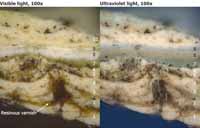 Sample PH26 from the westernmost front modillion
Sample PH26 from the westernmost front modillion
The cross-section below, also from sample PH26, has some of the earlier layers and all of the later generations of paint. In total there are nineteen generations of finish in the most complete cross-section from the pediment samples. The last four paint layers are nonfluorescent in reflected ultraviolet light and probably have synthetic modern binders.
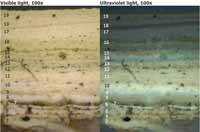 Sample PH26 from the westernmost front modillion
Sample PH26 from the westernmost front modillion
The finish history of the pediment is presented in table format below:
| Generations | Description | Notes |
|---|---|---|
| 16-19 | Modern tan paint | Applied in two coats, modern synthetic binder |
| 15 | Tan paint | Applied in two coats |
| 14 | Tan paint | Bluish autofluorescence |
| 13 | Tan paint | Grime above |
| 12 | Tan paint | Grime above |
| 11 | Cream-colored paint | Grime above |
| 10 | Cream-colored paint | Bright fluorescence, grime above |
| 9 | Cream-colored paint | Bluish autofluorescence |
| 8 | White paint | Zinc white pigment dates layer to 1840 or after |
| 7 | Olive green paint | Zinc white pigment dates layer to 1840 or after |
| 1-6 | Dark cream-colored paints | Grime and possible resin varnish above |
| Wood | Orange fluorescent sealant trapped in fibers |
The samples from the north door pediment can be compared to exterior samples taken from the building for the earlier examination of finishes at the President's House in February 2006. Chappell believes that the windows postdate the 1781 fire in the house, and in the set of samples taken in 2006, the windows had the most exterior paint evidence. In particular, sample PH14 from the exterior face of the sash of the first-floor window west of the north door had the most complete stratigraphy. The cross-section, which is shown below, begins with five generations of dark cream-colored paint. The first layer has impressions of wood fibers though the wood substrate is missing. Generation six is an olive green paint that is identical to the olive green paint of generation seven in the samples from the door pediment. Generation seven in the window sample is a thin layer with red pigments and a strong resinous component. This may be a color applied only to the sash as this red paint is not found in samples from the pediment.
The early layers are disrupted in all the samples, but there appears to be one less generation of dark cream-colored paint on the windows than on the pediment. This suggests that the pediment may be an earlier element, perhaps even predating the 1781 fire.
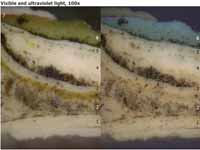 Sample PH14 from the sash of the first-floor window north of the north door
Sample PH14 from the sash of the first-floor window north of the north door
Results of Binding Media Analysis with Fluorochrome Stains
Two of the most complete cross-sections from samples PH25 and PH26 were stained with four biological fluorochrome stains to mark the presence of carbohydrates, proteins, and oils in the paint binders and the presence of zinc. When stained with DCF the earlier dark cream-colored paints reacted weakly for oils with a pink reaction color that indicates aged oils. Many of the later layers also reacted for oils. There were no noticeable reactions for proteins or carbohydrates in the early layers. Generation seven, an olive green paint, has a sparkly appearance in ultraviolet light which is indicative of zinc white pigment and the layer stained weakly for zinc when stained with TSQ. A more modern white paint flowed below the first generation of dark cream-colored paint and reacted strongly for zinc at the bottom of sample PH25.
Results of Pigment Identification
Pigment identification with polarized light microscopy was undertaken on the first cream-colored paint layer. This target layer in two uncast samples was scraped with a scalpel and the dispersed pigments were spread on a glass slide for examination. The dispersed pigments were compared to known pigments from a reference library and their optical and morphological properties were examined. In both scrapings, no colored pigments were detected, instead the paint appears to only have lead white and various other colorless extenders. The lead white pigments are large and rounded suggesting that this is a coarsely-ground, early paint. More modern production of lead white tends to produce much finer, more needlelike pigment particles.
Results of Color Measurement
The CIE L*a*b* color system was used for color measurement in which L* represents lightness to darkness with 100 being the brightest, a* represents red to green with positive numbers being more red, and b* represents yellow to blue with positive numbers being more yellow. A Munsell color system measurement was also made for future reference.
Since the earliest dark cream-colored paint was found to contain only white lead pigment, its current color is probably particularly due to the oil binder darkening with age, and to embedded grime. In some cases lead white pigment will degrade to black lead sulfide causing the paint to darken as well, but there was no evidence of this in the dispersed pigment samples. A fresh paint composed of lead white in linseed oil would certainly originally have been much lighter, though not equal to a modern "cool" white. A batch of lead white in linseed oil paint prepared by Susan Buck was measured to have a color value of L* 91.07, a* -1.26, b* 11.29. A good commercial paint match to this is Benjamin Moore OC-35 "Spanish White", which has a color value of L* 90.69, a* -1.67, b* 10.31. This is different from the reproduction paint by a very low ΔE value of only 1.13. (Accepted values are within a ΔE value range of ±2, as the human eye has trouble differentiating between two colors below this value). Hence, this paint could be used for reproducing a fresh applied lead white in linseed oil paint that the evidence suggests was originally on the pediment over the north door.
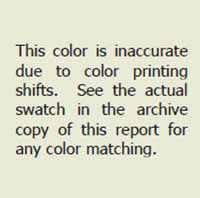 Benjamin Moore OC-35
Benjamin Moore OC-35
Best commercial match to fresh lead white in linseed oil
To get an accurate commercial paint match for the current degraded color of the earliest dark cream-colored paint, four samples were selected from uncast material from both samples PH25 and PH26 for colorimetry. Because the early paint is coarsely ground and weathered, its color is somewhat variable and twelve color measurements were taken from the uncast samples to get a average color value. The closest color measurement to the average was from sample PH25 and had a reading of L* 73.07, a* 0.48, b* 15.43. The Munsell color value of this sample is 2.5Y 7.2 / 2.4. A good commercial match is Benjamin Moore HC-82 "Bennington Gray", which has a color value of L* 73.08, a* -0.54, b* 15.47. This is different from the original paint color measurement by a ΔE value of only 1.02.
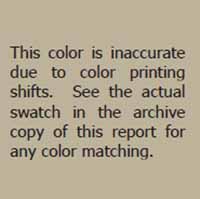 Benjamin Moore HC-82
Benjamin Moore HC-82
Best commercial match to aged originial paint
Three colorimetry readings were also taken of the current modern paint on the pediment from the uncast samples. This paint was found to have an average color measurement value of L* 66.71, a* 0.77, b* 16.98. This is different from the original paint by a ΔE value of 6.56, and is darker and slightly more yellow than Benjamin Moore "Bennington Gray" match. Hence, the current exterior trim color of the house is not a good match for the aged original paint or unweathered lead white in linseed oil paint.
Conclusion
The ten samples from the pediment over the north door of the President's House examined for this report have evidence of many early, weathered, degraded generations of paint. Samples PH25 and PH26 from the western modillions had at most six generations of degraded and darkened cream-colored oil paint before an olive green paint that can be dated to 1840 or after was applied. There is no certain way to determine the date of the first cream-colored paint generation on the pediment other than to say that it is consistent with the appearance and composition of an eighteenth-century paint.
However, it can be useful to compare the stratigraphy of the north door pediment with that of the windows. During sampling and examination of the house in November of 2005, Chappell noted that the windows appeared to date to after the 1781 fire based on their profiles. The most complete sample from the exterior face of the windows had only five generations of dark cream- colored paint. Thus, based on the few samples with limited evidence examined in this report, it appears that the pediment over the north door has one more layer of dark cream-colored paint than the windows. This suggests that it is an earlier element than the windows and might predate the 1781 fire. However, some of the paint evidence works against this theory. First, the early dark cream-colored paints are disrupted and weathered making it hard to be sure of the exact stratigraphy and the number of early layers. Second, if it is assumed that the pediment dates to the original construction of the house and was first painted around 1732, the cross-sections suggest it was not repainted until the windows were installed, presumably after the 1781 fire. The first paint generation is cracked but does not have a significant grime build-up that would indicate it was exposed for nearly fifty years. Third, if the fire in 1781 was as extreme as is suggested, evidence of charring and soot build-up would be expected in the first generation of paint on the pediment. Yet, there is no evidence of fire damage to the first paint layer. There is some grime, but this appears mostly above the fourth generation of paint on the pediment and is equal to grime in the window samples which are not thought to have survived the fire. Thus, despite the evidence gathered in this report a clear conclusion that the pediment over the north door predates the 1781 fire cannot be made.
Despite the lack of a clear date for the original paint layers, the samples still contain good evidence of an eighteenth-century exterior paint color used on an important civic building in Williamsburg. The finish history suggests that until around the middle of the nineteenth-century the trim on the house was painted with a lead white based cream-colored paint. And it might be supposed that this common paint color was applied to this building from its 1732 construction onward. A good color match was generated for the earliest paint that can be used to reproduce its aged, degraded appearance, or the trim could be repainted with a match for unaged lead white in linseed oil paint that is also provided in this report. Either color would be more representative of the early history of the building than the current trim color which is significantly darker and more yellow than even the aged original paint.
Footnotes
Appendix
Sampling Memorandum
May 12, 2006
To: Natasha LoeblichFrom: Ed Chappell
Subject: Paint Samples — North Pediment of President's House, College of William & Mary
Block 16, Building 2
Attached are samples I took from the 18th-century pediment over the north door of the President's House this morning.
Mark Kutney found no early paint when he sampled the pediment several years ago, and the modern layers look very thick. However, the scaffolding for brickwork repair offered me access to all exposed surfaces, so I hope that samples from protected corners may be more informative.
I realize you will not work with these until you return to Williamsburg in the Fall.
- 1. Westernmost (side) modillion, north face at upper east corner adjoining cymatium. This and other modillions are very hard, walnut?
- 2.Penultimate modillion, counting from the east (westernmost front), east side at upper south corner adjoining cymatium.
- 3.Second (first front) modillion, counting from east, north face 1" below cymatium.
- 4.Same modillion as #3, west side, ½" back from front, adjoining cymatium.
- 5.Fascia between second and third modillions 1" east of third one, adjoining cymatium. Wood seems softer, probably pine.
- 6.Same, below, at junction with bed molding fillet. Possibly water damaged.
- 7.Third (second front) modillion, middle of west cymatium.
- 8.Upper (raking) fascia beside middle (top) modillion, adjoining cymatium. Hopefully a good sample, appearing to have numerous layers on what looks like pine.
- 9.Westernmost upper (raking) modillion, west lower edge ¾" back from front. May not include early finish.
- 10.Upper (raking) soffit, 1" west of second modillion, 2" back from fascia. Looks like pine.
E.A.C.
Copy: Susan Buck
Louise Kale
Mark R. Wenger
Cross-section Preparation Procedures
The samples were initially examined with a stereomicroscope under low power magnification (5 to 50 times magnification) and divided as needed. When possible, a portion of each sample was kept in reserve for future analysis and a portion cast in a labeled cube of a commercial two-part polyester resin manufactured by Excel Technologies, Inc. (Enfield, CT). The resin was cured under an incandescent lamp for several hours. The resin cubes were then ground on a motorized grinding wheel with 400 grit sandpaper to reveal the cross-sections. Final finishing was achieved using a Buehler Metaserv 2000 grinder polisher equipped with abrasive cloths from Micro Mesh, Inc. with grits of 1500 to 12,000.
Cross-section microscopy analysis was performed using a Nikon Eclipse 80i microscope equipped with an EXFO X-Cite 120 Fluorescence Illumination System fiberoptic halogen light source. The cross-sections were examined at magnifications of 40x, 100x, 200x, and 400x using reflected visible light and a UV-2A fluorescence filter cube with a 330-380nm excitation. The cross-sections were photographed digitally using an integral Spot Flex digital camera with Spot Advanced (v. 4.6) software. The light levels of the images were adjusted in Abode Photoshop (v. 6.0). The color in the digital images is indicative of the actual color of the paints, but cannot be used for color matching as the printing process can cause color shifts.
Under ultraviolet light many materials have characteristic autofluorescence colors that can suggest their composition. For example, most natural resin varnishes have a bright autofluorescence while an oil varnish will be dark in ultraviolet light. Visible light microscopy can also yield valuable information. The presence of soiling layers or weathering can indicate that the finish layer existed as a presentation surface for a period of time. Since many interior finishes, such as faux graining, make use of a build-up of layers, it is important to determine which layers were meant to be final presentation surfaces.
Binding Media Analysis Procedures
To better understand the composition of the paint binders, selected cross-sections were stained with biological fluorochrome stains to indicate the presence of carbohydrates, proteins, and oils in the paint binders. The stains used were FLUR (0.5% w/v fluorescamine in anhydrous acetone) which stains proteins blue-white, TTC (4% w/v triphenyl tetrazolium chloride in methanol) which stains carbohydrates red-brown, DCF (0.2% w/v 2,7 dichlorofluorescein in ethanol) which stains saturated lipids pink and unsaturated lipids yellow, and TSQ (0.2% w/v N-(6-methyl-8-quinolyl)-p-toluenesulfonamide in ethanol) which stains zinc blue-white.
Pigment Identification Procedures
Samples with good accumulations of early paints identified through cross-section microscopy analysis were scraped with a scalpel under magnification to reveal the target paint layer. A small amount of this layer was then scraped onto a glass microscope slide, dispersing the pigments. The dispersed pigments were permanently embedded under a cover slip in Cargille Meltmount (Cargille Labs., Cedar Grove, NJ). The Meltmount used has a refractive index of 1.662. The prepared slides were then examined under the microscope with transmitted visible light using a polarizing filter at a magnification of 1000x with an oil immersion objective. The morphological and optical properties of the pigment particles was observed and compared to reference pigment samples.
Color Measurement Procedures
Color measurements were made using uncast samples that were selected under magnification. All color measurements were made using a Minolta Chromameter CR-241 with a measurement area of 0.3mm for uncast samples and a measurement area of 1.8mm for paint swatches. This microscope has an internal, 360° pulsed xenon arc lamp and can measure color with five color systems. The color systems used in this report are the CIE (Commission International de l'Eclairage) L*a*b* and the Munsell color system. Both systems use three values called tristimulus values to measure each color, which include hue (or color), the chroma (or saturation), and lightness to darkness. In the CIE L*a*b* color system L* represents lightness with 100 being the brightest, a* represents red to green with positive numbers being more red and negative numbers more green, and b* represents yellow to blue with positive numbers being more yellow and negative numbers more blue. In the Munsell system, color measurements are given in the form of hue value/chroma with value representing lightness to darkness. Color measurement values are compared to each other using the ΔE formula1 which calculates the difference between two color measurements. Generally, a ΔE value of less than two represents colors that are difficult for the human eye to differentiate.
